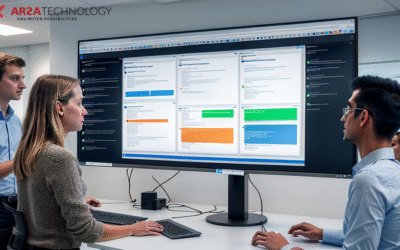Introduction: Overcoming Inaccurate Patient Identity Verification in the Healthcare Industry
In the fast-evolving landscape of healthcare, precision and security are not just desired outcomes—they are absolute necessities. Yet, a persistent challenge continues to plague institutions globally: inaccurate patient identity verification. This critical pain point can lead to a cascade of adverse effects, from medical errors and treatment delays to insurance fraud and severe compliance breaches. Legacy identification systems, often reliant on manual checks or outdated technologies, simply cannot keep pace with the demands for robust security and seamless patient experiences.
ARSA Technology understands these intricate challenges. We specialize in providing high-performance AI API products designed to empower global enterprises and developers. Our Face Recognition API offers a transformative solution, enabling healthcare providers to move beyond the limitations of traditional methods and embrace a new era of secure, efficient, and accurate patient identification. This article outlines a strategic, step-by-step migration plan for upgrading to ARSA’s Face Recognition API, ensuring enhanced security monitoring and a future-proof foundation for your healthcare operations.
The Critical Imperative: Why Legacy Systems Fail Healthcare
For too long, healthcare facilities have grappled with the vulnerabilities inherent in legacy identity verification systems. These systems often rely on physical IDs, manual data entry, or outdated biometric methods that are prone to human error, susceptible to fraud, and create bottlenecks in patient flow. The consequences are far-reaching:
- Patient Safety Risks: Misidentification can lead to incorrect diagnoses, inappropriate treatments, and medication errors, directly jeopardizing patient well-being.
- Financial Losses: Fraudulent claims, duplicate records, and administrative inefficiencies stemming from poor identification cost the healthcare industry billions annually.
- Compliance Penalties: Strict regulations like HIPAA demand rigorous patient data protection. Inaccurate identification systems can lead to severe non-compliance penalties and reputational damage.
- Operational Inefficiency: Slow verification processes lead to longer wait times, frustrated patients and staff, and reduced capacity for care delivery.
The need for a modern, reliable, and scalable solution for secure identity verification solutions has never been more urgent. ARSA Technology’s Face Recognition API offers that solution, providing the accuracy and speed necessary to safeguard patients and streamline operations.
Introducing ARSA Technology’s Face Recognition API: A New Standard for Healthcare
ARSA Technology’s Face Recognition API is engineered for precision, speed, and reliability. It leverages advanced AI algorithms to accurately identify individuals by comparing facial features against a database of known identities. This capability is not just about recognizing faces; it’s about establishing a foundation of trust and security in every patient interaction.
Our API is designed to integrate seamlessly into existing healthcare management systems, patient portals, and access control points, providing a powerful layer of biometric security without disrupting established workflows. Imagine a scenario where a patient checks in, and their identity is verified instantly and accurately, minimizing wait times and maximizing security. To understand the precision and speed of this verification process, try the Face Recognition API on RapidAPI. This interactive demo illustrates how effectively the API processes facial data for identification.
Phase 1: Strategic Assessment and Comprehensive Planning
A successful migration begins with meticulous planning. This phase is crucial for understanding your current infrastructure, defining clear objectives, and laying the groundwork for a smooth transition.
1. Evaluate Current Identity Verification Processes: Document every step of your existing patient identification workflow. Identify bottlenecks, security vulnerabilities, and areas where inaccurate verification occurs most frequently. Understand the limitations of your legacy systems, whether they are outdated hardware, manual processes, or insufficient software capabilities.
2. Define Clear Migration Objectives: What specific improvements do you aim to achieve? Examples include:
* Reducing patient misidentification rates by a measurable percentage.
* Decreasing patient check-in times.
* Enhancing overall security for restricted areas.
* Improving compliance with data protection regulations.
* Mitigating the risk of medical identity theft.
3. Identify Key Stakeholders and Form a Migration Team: Assemble a cross-functional team including IT managers, software developers, clinical staff, security officers, and compliance experts. Their collective input will ensure the solution meets diverse needs across the organization.
4. Data Strategy and Preparation: Plan how existing patient biometric data (if any) will be migrated or how new data will be securely enrolled. Consider data privacy regulations and ethical guidelines for biometric data handling.
5. Resource Allocation and Budgeting: Determine the necessary financial, human, and technological resources for the migration. This includes potential training for staff and any necessary infrastructure upgrades.
Phase 2: Seamless Integration Strategy and Phased Implementation
With a solid plan in place, the next phase focuses on integrating ARSA Technology’s Face Recognition API into your healthcare ecosystem. Our API is built for developer-friendly integration, minimizing complexity.
1. Architectural Design and System Mapping: Design how the Face Recognition API will interact with your existing Electronic Health Records (EHR) systems, patient management platforms, and access control mechanisms. Identify the specific points in the patient journey where facial recognition will be applied (e.g., check-in, medication dispensing, secure area access).
2. Pilot Program Development: Before a full-scale rollout, implement a pilot program in a controlled environment or a specific department. This allows your team to:
* Test the API’s performance with real-world data and scenarios.
* Gather feedback from end-users (patients and staff).
* Identify and resolve any integration challenges in a low-risk setting.
* Refine workflows and user interfaces for optimal experience.
3. Secure Data Enrollment and Management: Establish a secure and user-friendly process for enrolling patients into the facial recognition system. Emphasize consent, data encryption, and strict access controls to protect sensitive biometric information. This is also where you might consider complementary solutions for preventing fraud with liveness detection to ensure the enrolled individual is physically present and not using a spoofed image.
4. Developer Support and Documentation: ARSA Technology provides comprehensive documentation and support to facilitate a smooth integration process. Our resources are designed to help your development team quickly understand the API’s capabilities and how to leverage them effectively. For a hands-on experience, remember you can try the Face Recognition API on RapidAPI to see its practical application.
Phase 3: Rigorous Testing, Strategic Deployment, and Continuous Optimization
The final phase ensures the deployed solution is robust, reliable, and continuously optimized to meet evolving healthcare needs.
1. Comprehensive Testing and Validation: Conduct thorough testing across all integrated systems. This includes performance testing under various loads, security audits to ensure data protection, and user acceptance testing (UAT) to confirm the system meets operational requirements. Validate the accuracy of the face recognition across diverse demographics and lighting conditions.
2. Phased Rollout Strategy: Instead of a “big bang” deployment, consider a phased rollout. Start with a smaller department or clinic, gather feedback, make adjustments, and then expand gradually across the organization. This approach minimizes disruption and allows for continuous improvement.
3. Staff Training and Change Management: Provide comprehensive training for all staff who will interact with the new system. Address concerns, highlight benefits, and ensure they are proficient in using the Face Recognition API. Effective change management is key to user adoption and overall success.
4. Performance Monitoring and Iterative Improvement: Once deployed, continuously monitor the API’s performance, accuracy, and impact on operational efficiency. Establish metrics to track improvements in patient identification rates, check-in times, and security incidents. Use this data to identify areas for further optimization and leverage ARSA Technology’s updates and enhancements.
5. Scalability Planning: As your healthcare organization grows, ensure your facial recognition solution can scale with it. ARSA Technology’s API is built for enterprise-grade performance, capable of handling high volumes of requests and expanding patient databases.
Key Benefits Post-Migration: A Secure and Efficient Future for Healthcare
Migrating to ARSA Technology’s Face Recognition API delivers tangible benefits that directly address the core pain point of inaccurate patient identity verification:
- Enhanced Patient Safety: Dramatically reduces the risk of misidentification, leading to safer medical care and improved patient outcomes.
- Fraud Prevention: Fortifies defenses against medical identity theft and fraudulent claims, protecting both patients and your organization’s financial integrity.
- Operational Efficiency: Accelerates patient check-in and administrative processes, reducing wait times and freeing up staff to focus on patient care.
- Regulatory Compliance: Strengthens your organization’s ability to meet stringent data privacy and security regulations, mitigating legal and reputational risks.
- Improved Patient Experience: Offers a modern, seamless, and secure identification experience that instills confidence and satisfaction.
- Future-Proof Security: Positions your institution at the forefront of healthcare technology, ready to adapt to future security challenges and innovations.
Conclusion: Your Next Step Towards a Solution
The journey from legacy systems to advanced biometric identity verification is a strategic investment in the future of healthcare. By adopting ARSA Technology’s Face Recognition API, your organization can effectively combat inaccurate patient identity verification, elevate security standards, and significantly enhance operational efficiency. This migration is not merely a technical upgrade; it’s a commitment to superior patient care, robust security, and a more streamlined healthcare experience.
ARSA Technology is your trusted partner in this transformation. Our high-performance AI API products are designed to empower developers and enterprises to build secure, innovative, and impactful solutions. We invite you to explore the capabilities of our Face Recognition API and take the decisive step towards a more secure and efficient future for your healthcare institution.
Ready to Solve Your Challenges with AI?
Discover how ARSA Technology can help you overcome your toughest business challenges. Get in touch with our team for a personalized demo and a free API trial.







